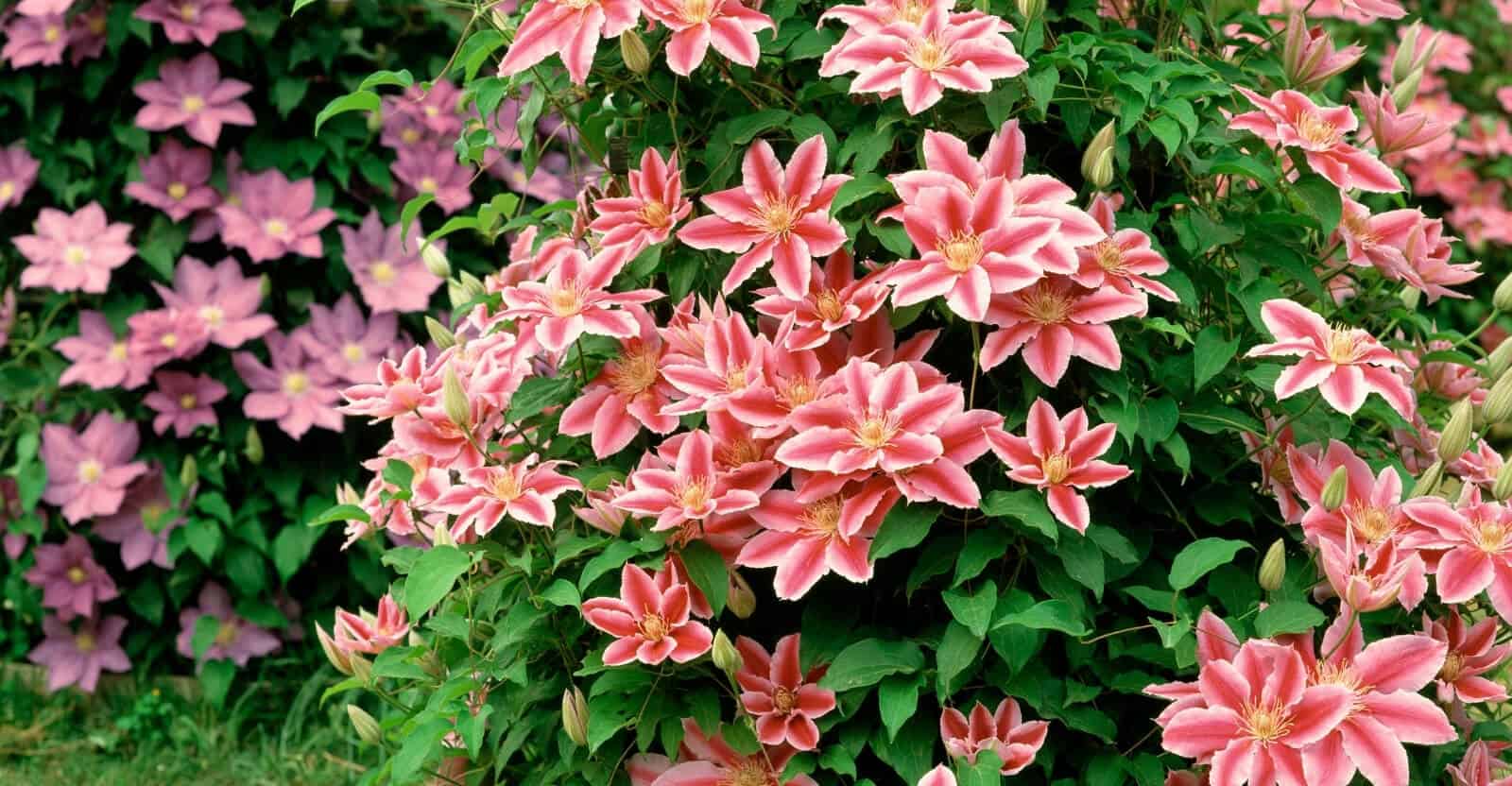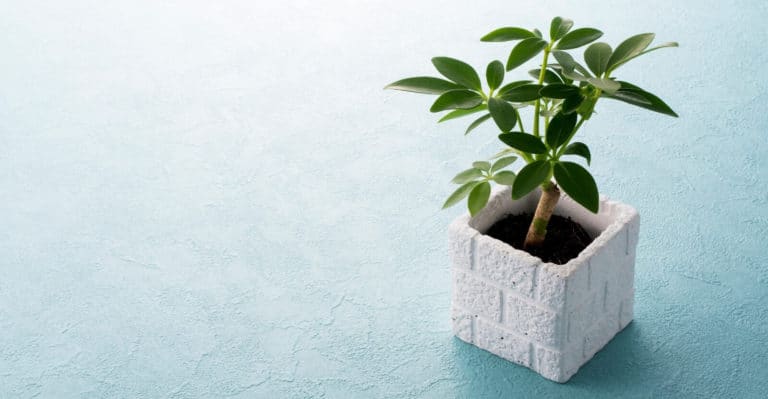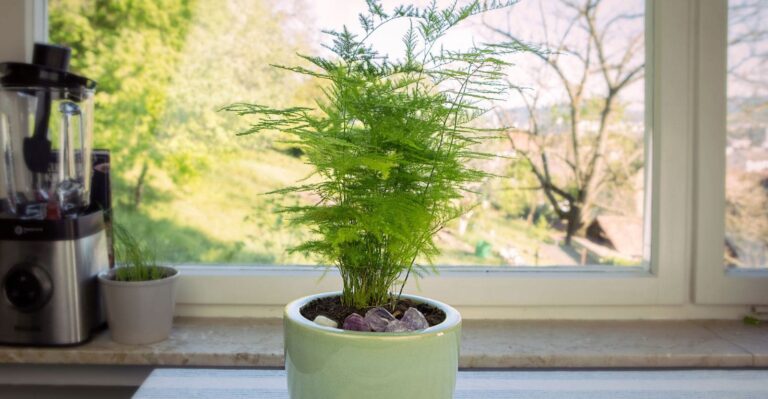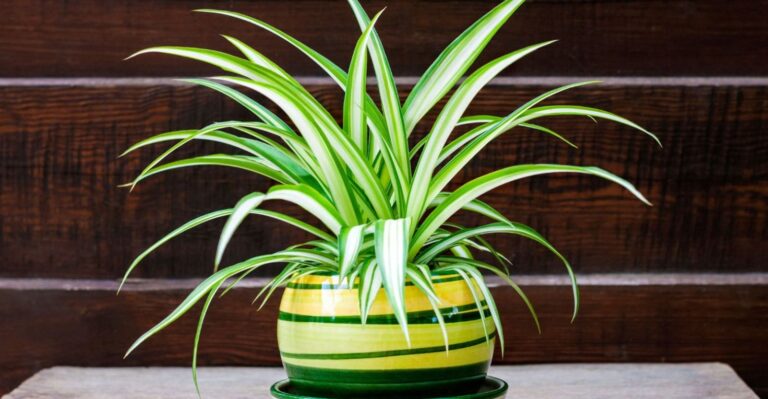Amazon has put together some great Home Gift Deals – save money and get your shopping done at the comfort of your home! Click here to see deals on Amazon
Clematis is a spring-flowering plant that belongs to the Atragene group of plants. They bloom small bell-shaped flowers that bring particular charm to the garden. The dark pointed flower buds grow from the small thin branches full of serrated leaves.
The clematis flower remains down pointed, giving the appearance of bells in the garden. The flower lasts for several weeks in the spring and is their favorite flower for home gardeners.
Clematis are among the easiest plants to grow and care for and are popular for climber plants. Once the plants are established, they require little care other than occasional pruning.
Clematis blooms a wide color range of flowers from white, pink, plum, blue to mauve, producing a beautiful flower peak from April through May, depending on the species, blossoming stage, and climate. The clematis flowers lack fragrance, but they’re pretty appealing. Clematis grows best in the hardiness zone of 4-9.
What are the popular clematis varieties?
Clematis is one of the most popular flowers to grow in the garden. They come in various colors and can be grown in a wide range of climates. The most popular clematis varieties are the pink and white butterfly, the lace-like sweet bell, and the trumpet-shaped jonquil.
Clematis is a hardy plant and can withstand harsh winter and windy situations. With proper support, they can withstand coastal winds with no problem.
As it belongs to the Atragenes group of families, Clematis alpina and C.macropetala are the two most common varieties available in garden centers. The former is originated from Northern Europe and Asia, while the latter comes from China and Siberia.
The colorful, green sepal (flower bud cover) surrounding a clematis flower isn’t a fundamental part of the flower. While in other flowers, it either drops off or has no further use once the flower is open, in clematis’s the main floral attraction.
The petals of clematis are around the center of the flower. These are called staminodes, a combination of a stamen and petal. In C. Alpina, these petals are broad cylinder-shaped, while in C. macropetala these petals are narrow and pointed.
Here are the several popular species of clematis that will grow up to 8 ft (2.4 m) tall when fully mature.
| Clematis alpina | Clematis macropetala |
|---|---|
| Francis Rivis: It has broad, twisted lavender sepals with white petaloid | Octopus: Reliable but relatively new cultivar with narrow sepals of purple color that blooms in spring. |
| Ocean Pearl: Beautiful white petaloid with few white petals. The bloom gets denser as the plant grows. | Markham’s pink: An ancient cultivar that produces a full-sized double flower. |
| Rosa Pagoda: light pink colored long-sepalled flower. A very sturdy plant that can be grown in any condition. | Sorbet: Blooms pink spiky flowers that look great in the front of garden hedges. |
| Constance: It has rich deep-pink flowers that look good with other companion plants. | Spiky: Lavender flowers that look beautiful in the spring with other companion flowers. |
| Stolwijk Gold: Golden leaves with lavender-blue flower makes it a perfect background to the blooms. | Country Rose: It has spiky sepals with a pink color flower. |
| White Columbine: Blooms in spring with a snow-white flower. |
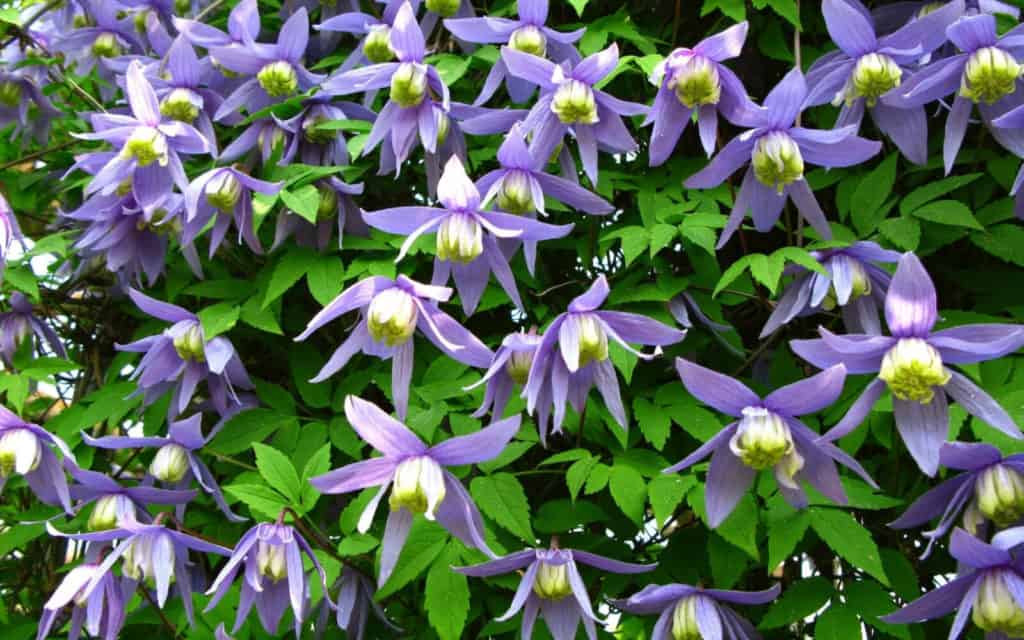
How big does the clematis flower grow?
The clematis flower has four hairy sepals with a trumpet shape. These sepals grow around 1.5 inches (4 cm) in C. alpina and up to 2 inches (5 cm) long in C. macropetala. The center of the flower is usually filled with tiny white petals.
Several cultivated forms of clematis are available to grow a semi-double flower or even bigger flower size in the market. The leaflets of clematis are coarsely toothed with green foliage, and each leaf is divided into nine leaflets.
You can plant clematis with forsythia or pink robes that make a perfect combination in a ground-level flower garden. If you climb it on a wall, they make a good match with variegated ivies due to dense growth in the summer.
When should clematis be planted?
Clematis is a sturdy plant that can withstand frost and cold winds. They flourish in the sun or partially shaded areas, while some flowering climbers thrive in the east-facing position. Although there are several different ways you can grow clematis, cutting is the easiest route to get a new plant.
You can usually take a cutting from the current plant in July and plant it in the fertile, moist ground out of direct sunlight. The cuttings start growing roots by autumn and produce shoots in spring.
If you want better flexibility and a wide range of clematis that you want to grow, March and April are the best time to plant clematis. It allows you to choose different clematis varieties while it’s in bloom. You have to ensure that the new plant’s roots are soaked well and thoroughly watered after the planting.
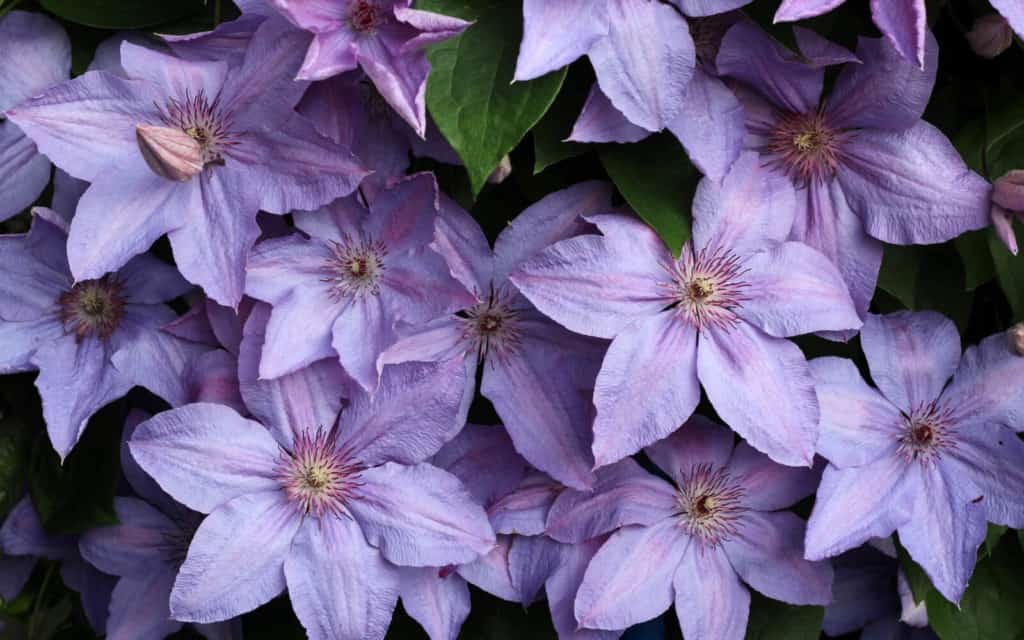
How to propagate clematis?
Clematis is a perennial flowering plant that is usually grown from cuttings. You can propagate it by taking stem cuttings, layering seeds, or division of roots. If you’re growing it from a seed, you should sow it in autumn, leaving it outside during the winter, and the germination starts in the spring.
You have to be a bit careful with seed propagation as seeds of cultivars won’t breed the same as the parent plant due to the hybrid origin of the plant, and it takes several years for them to reach flowering size. Cutting is the best way to grow identical to the parent plant.
You should select a healthy clematis parent to take the cutting. Remove the top 12 inches (30 cm) of the soft and sappy shoot. You should cut the stem above the pair of leaves and trim the base around 3 inches (8 cm) below.
You will get cutting with leaves at the top and a bare stem below. Keep half the leaves on the stem to reduce any water loss. You should plant the cutting in a pot or directly in the ground.
Place it in a moist, warm place, out of direct sunlight, and a new shoot will start to appear in a few months. Healthy growing clematis gains at least 24 inches (60 cm) growth per year.
How deep does a clematis need to be planted?
You should plant it a little deeper than usual to ensure that your clematis is getting the best possible start in life. Depending on the type of clematis, you should let the cutting inserted at least 4 inches (10 cm) deep in the ground. Leave the node where the leaves meet the stem at or below the soil level.
When planting in potting soil, add half perlite and half compost with enough support for the plant to grow and develop into a climber. Check the ground for any weak or missing spots, and give the vine support.
A climbing vine needs to be planted no deeper than its growing medium allows. Sometimes, you can plant it directly into the ground, but most are grown in pots for ease of care.
How do you take care of clematis?
Clematis are vines that grow best in light, well-drained soil. They need room to grow, so make sure you have at least 3 to 4 feet of growing space for each clematis you want to grow. When adequately developed, they can add beauty and color to your home or garden.
Clematis are relatively low-maintenance plants that are easy to take care of. You usually don’t need to prune them, but they start to look untidy if their growth has become excessive. If you don’t prune frequently, the clematis grows higher each year with more slow and dense growth in the center.
Removing this dead growth allows the new healthy shoots to cover the area and gives a friendlier appearance in the garden. Clematis flowers are produced in April on growth from a prior year, and you can start pruning around May. This gives the clematis to recover and shoot new growth for bloom in the following spring.
When planted in a patio or pot and you don’t want it to keep growing tall each year, you can prune it annually to maintain the same height. It grows best in moist soil types, whether acid, neutral or alkaline, as long as the area has good drainage.
Clematis are long-lived plants, and if you maintain moist but well-drained soil conditions with a little bit of manure and compost added to it, it will thrive for several years to come.
Clematis will produce more blooms and have dense foliage when they receive full sunlight to grow. But if you can’t provide at least 6 to 8 hours of daylight, they can tolerate growing in semi-shade areas, including east-facing walls and fences.
If you’ve grown clematis in a pot, it must be regularly watered and fed. You may also have to repot it after a few years and protect it against aphids and powdery mildew as they damage the young tender shoots of clematis.
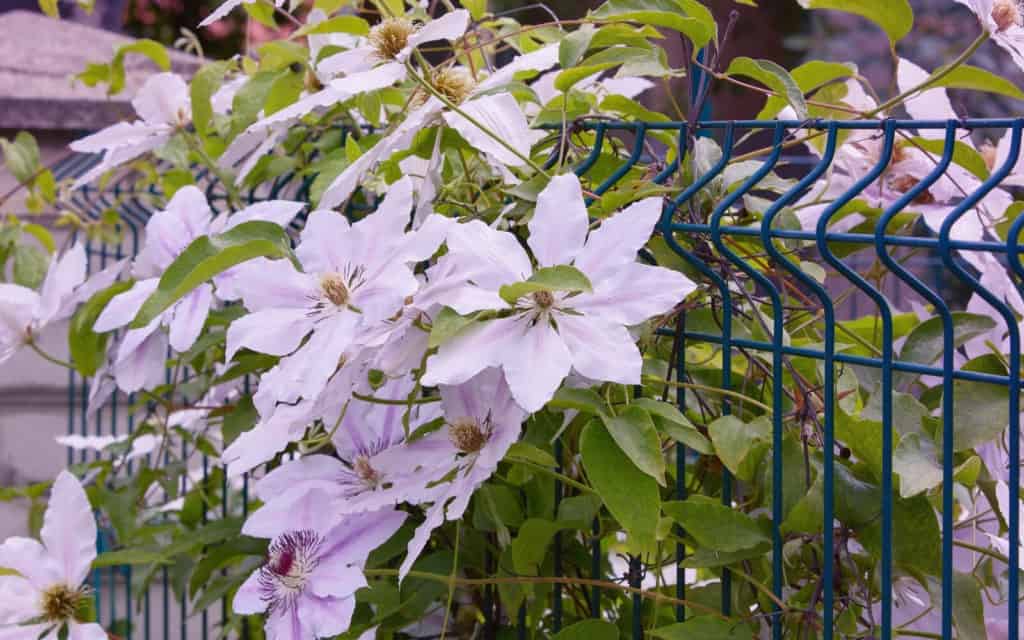
How to grow clematis on a fence?
Clematis can be grown on fences in a variety of ways. Some people tie the vine to the fence posts, while others use wire or cable ties. Clematis can also be grown-up trellises made of poles set at a right angle to the fence.
Remember that the clematis climb using leaf stalks that curl up around support. The clematis stems don’t do twine, due to which the fence or trellis should be of a smaller diameter. You can use a wire trellis to climb the clematis or a large-profile chicken wire.
C. alpina is most suitable for wall-sided borders, and it grows up to 8 ft (2.5 cm) tall and spread up to 5 ft (1.5 m). You can guide it along the fence or trellis but will need a broad network of support while making a dense wall of growth that is good for screening and privacy.
Whether growing clematis on the fence or any other support medium, make sure that their top should face toward the sun, and the bottom should be in the shade. You can achieve this by planting it beside another shrub that will shade the bottom and moving the top part of the plant to the front of the shrub facing the sun.
The clematis flowers attract garden-friendly insects such as bees and butterflies that help pollinate other flowers in the garden. A highly dense clematis shrub is also the preferred nesting spot for birds.
Conclusion
Clematis is a beautiful spring flowering plant that adds charm to any garden. They’re easy to care for and come in various colors that will brighten any space. If you’re looking for a way to add some color to your garden this spring, consider planting clematis.

Don’t forget to share this post

